ASUS P8Z68-V LE User Manual

P8Z68-V LE
Motherboard

E6690
First Edition (V1)
June 2011
Copyright © 2011 ASUSTeK Computer Inc. All Rights Reserved.
No part of this manual, including the products and software described in it, may be reproduced, transmitted, transcribed, stored in a retrieval system, or translated into any language in any form or by any means, except documentation kept by the purchaser for backup purposes, without the express written permission of ASUSTeK Computer Inc. (“ASUS”).
Product warranty or service will not be extended if: (1) the product is repaired, modified or altered, unless such repair, modification of alteration is authorized in writing by ASUS; or (2) the serial number of the product is defaced or missing.
ASUS PROVIDES THIS MANUAL “AS IS” WITHOUT WARRANTY OF ANY KIND, EITHER EXPRESS OR IMPLIED, INCLUDING BUT NOT LIMITED TO THE IMPLIED WARRANTIES OR CONDITIONS OF MERCHANTABILITY OR FITNESS FOR A PARTICULAR PURPOSE. IN NO EVENT SHALL ASUS, ITS DIRECTORS, OFFICERS, EMPLOYEES OR AGENTS BE LIABLE FOR ANY INDIRECT, SPECIAL, INCIDENTAL, OR CONSEQUENTIAL DAMAGES (INCLUDING DAMAGES FOR LOSS OF PROFITS, LOSS OF BUSINESS, LOSS OF USE OR DATA, INTERRUPTION OF BUSINESS AND THE LIKE), EVEN IF ASUS HAS BEEN ADVISED OF THE POSSIBILITY OF SUCH DAMAGES ARISING FROM ANY DEFECT OR ERROR IN THIS MANUAL OR PRODUCT.
SPECIFICATIONS AND INFORMATION CONTAINED IN THIS MANUAL ARE FURNISHED FOR INFORMATIONAL USE ONLY, AND ARE SUBJECT TO CHANGE AT ANY TIME WITHOUT NOTICE, AND SHOULD NOT BE CONSTRUED AS A COMMITMENT BY ASUS. ASUS ASSUMES NO RESPONSIBILITY OR LIABILITY FOR ANY ERRORS OR INACCURACIES THAT MAY APPEAR IN THIS MANUAL, INCLUDING THE PRODUCTS AND SOFTWARE DESCRIBED IN IT.
Products and corporate names appearing in this manual may or may not be registered trademarks or copyrights of their respective companies, and are used only for identification or explanation and to the owners’ benefit, without intent to infringe.
Offer to Provide Source Code of Certain Software
This product may contain copyrighted software that is licensed under the General Public License (“GPL”) and under the Lesser General Public License Version (“LGPL”). The GPL and LGPL licensed code in this product is distributed without any warranty. Copies of these licenses are included in this product.
You may obtain the complete corresponding source code (as defined in the GPL) for the GPL Software, and/or the complete corresponding source code of the LGPL Software (with the complete machinereadable “work that uses the Library”) for a period of three years after our last shipment of the product including the GPL Software and/or LGPL Software, which will be no earlier than December 1, 2011, either
(1)for free by downloading it from http://support.asus.com/download;
or
(2)for the cost of reproduction and shipment, which is dependent on the preferred carrier and the location where you want to have it shipped to, by sending a request to:
ASUSTeK Computer Inc.
Legal Compliance Dept. 15 Li Te Rd.,
Beitou, Taipei 112 Taiwan
In your request please provide the name, model number and version, as stated in the About Box of the product for which you wish to obtain the corresponding source code and your contact details so that we can coordinate the terms and cost of shipment with you.
The source code will be distributed WITHOUT ANY WARRANTY and licensed under the same license as the corresponding binary/object code.
This offer is valid to anyone in receipt of this information.
ASUSTeK is eager to duly provide complete source code as required under various Free Open Source Software licenses. If however you encounter any problems in obtaining the full corresponding source code we would be much obliged if you give us a notification to the email address gpl@asus.com, stating the product and describing the problem (please do NOT send large attachments such as source code archives etc to this email address).
ii

Contents
Notices......................................................................................................... |
vi |
Safety information...................................................................................... |
vii |
About this guide........................................................................................ |
viii |
P8Z68-V LE specifications summary......................................................... |
ix |
Chapter 1 |
Product introduction |
|
|
1.1 |
Welcome!....................................................................................... |
1-1 |
|
1.2 |
Package contents......................................................................... |
1-1 |
|
1.3 |
Special features............................................................................ |
1-1 |
|
|
1.3.1 |
Product highlights............................................................ |
1-1 |
|
1.3.2 |
Innovative ASUS features................................................ |
1-4 |
1.3.3Intel® Smart Response Technology & LucidLogix® VirtuTM
|
|
Solution............................................................................ |
1-6 |
1.4 |
Before you proceed...................................................................... |
1-9 |
|
1.5 |
Motherboard overview............................................................... |
1-10 |
|
|
1.5.1 |
Placement direction....................................................... |
1-10 |
|
1.5.2 |
Screw holes................................................................... |
1-10 |
|
1.5.3 |
Motherboard layout......................................................... |
1-11 |
|
1.5.4 |
Layout contents.............................................................. |
1-11 |
1.6 |
Central Processing Unit (CPU).................................................. |
1-12 |
|
|
1.6.1 |
Installing the CPU.......................................................... |
1-12 |
|
1.6.2 |
Installing the CPU heatsink and fan.............................. |
1-15 |
|
1.6.3 |
Uninstalling the CPU heatsink and fan.......................... |
1-16 |
1.7 |
System memory.......................................................................... |
1-17 |
|
|
1.7.1 |
Overview........................................................................ |
1-17 |
|
1.7.2 |
Memory configurations.................................................. |
1-19 |
|
1.7.3 |
Installing a DIMM........................................................... |
1-24 |
|
1.7.4 |
Removing a DIMM......................................................... |
1-24 |
1.8 |
Expansion slots.......................................................................... |
1-25 |
|
|
1.8.1 |
Installing an expansion card.......................................... |
1-25 |
|
1.8.2 |
Configuring an expansion card...................................... |
1-25 |
|
1.8.3 |
PCI Express 2.0 x1 slots............................................... |
1-25 |
|
1.8.4 |
PCI Express 2.0 x16 slots............................................. |
1-25 |
|
1.8.5 |
PCI slots........................................................................ |
1-25 |
1.9 |
Jumpers |
....................................................................................... |
1-26 |
iii

Contents
1.10 |
Connectors.................................................................................. |
1-27 |
|
|
1.10.1 |
Rear panel connectors.................................................. |
1-27 |
|
1.10.2 |
Internal connectors........................................................ |
1-29 |
1.11 |
Onboard switches....................................................................... |
1-35 |
|
1.12 |
Onboard LEDs............................................................................. |
1-36 |
|
1.13 |
Software support........................................................................ |
1-38 |
|
|
1.13.1 Installing an operating system....................................... |
1-38 |
|
|
1.13.2 |
Support DVD information............................................... |
1-38 |
Chapter 2 |
BIOS information |
|
|
2.1 |
Managing and updating your BIOS............................................. |
2-1 |
|
|
2.1.1 |
ASUS Update utility......................................................... |
2-1 |
|
2.1.2 |
ASUS EZ Flash 2............................................................ |
2-2 |
|
2.1.3 |
ASUS CrashFree BIOS 3 utility....................................... |
2-3 |
|
2.1.4 |
ASUS BIOS Updater....................................................... |
2-4 |
2.2 |
BIOS setup program..................................................................... |
2-7 |
|
2.3 |
Main menu................................................................................... |
2-11 |
|
|
2.3.1 |
System Language [English]............................................ |
2-11 |
|
2.3.2 |
System Date [Day xx/xx/xxxx]........................................ |
2-11 |
|
2.3.3 |
System Time [xx:xx:xx]................................................... |
2-11 |
|
2.3.4 |
Security........................................................................... |
2-11 |
2.4 |
Ai Tweaker menu........................................................................ |
2-13 |
|
|
2.4.1 |
Ai Overclock Tuner [Auto].............................................. |
2-14 |
|
2.4.2 |
Turbo Ratio [By All Cores]............................................. |
2-14 |
|
2.4.3 |
Internal PLL Overvoltage [Auto]..................................... |
2-14 |
|
2.4.4 |
Memory Frequency [Auto]............................................. |
2-14 |
|
2.4.5 |
iGPU Max. Frequency [Auto]......................................... |
2-14 |
|
2.4.6 |
EPU Power Saving Mode [Disabled]............................. |
2-15 |
|
2.4.7 |
OC Tuner....................................................................... |
2-15 |
|
2.4.8 |
DRAM Timing Control.................................................... |
2-15 |
|
2.4.9 |
CPU Power Management.............................................. |
2-15 |
|
2.4.10 |
CPU Offset Mode Sign [+]............................................. |
2-16 |
|
2.4.11 |
iGPU Offset Mode Sign [+]............................................ |
2-16 |
iv

Contents
|
2.4.12 |
DRAM Voltage [Auto]..................................................... |
2-16 |
|
2.4.13 |
VCCIO Voltage [Auto].................................................... |
2-17 |
|
2.4.14 |
PCH Voltage [Auto]........................................................ |
2-17 |
|
2.4.15 |
Load-Line Calibration [Auto].......................................... |
2-17 |
|
2.4.16 |
CPU Spread Spectrum [Auto]........................................ |
2-17 |
2.5 |
Advanced menu.......................................................................... |
2-18 |
|
|
2.5.1 |
CPU Configuration......................................................... |
2-18 |
|
2.5.2 |
System Agent Configuration.......................................... |
2-20 |
|
2.5.3 |
PCH Configuration......................................................... |
2-20 |
|
2.5.4 |
SATA Configuration........................................................ |
2-20 |
|
2.5.5 |
USB Configuration......................................................... |
2-21 |
|
2.5.6 |
Onboard Devices Configuration.................................... |
2-21 |
|
2.5.7 |
APM............................................................................... |
2-23 |
2.6 |
Monitor menu.............................................................................. |
2-24 |
|
|
2.6.1 |
CPU Temperature / MB Temperature [xxxºC/xxxºF]...... |
2-25 |
|
2.6.2 |
CPU / Chassis / Power Fan Speed [xxxx RPM] or |
|
|
|
[Ignore] / [N/A]................................................................ |
2-25 |
|
2.6.3 |
CPU Q-Fan Control [Enabled]....................................... |
2-25 |
|
2.6.4 |
Chassis Q-Fan Control [Enabled].................................. |
2-26 |
|
2.6.5 |
CPU Voltage, 3.3V Voltage, 5V Voltage, 12V Voltage... |
2-26 |
|
2.6.6 |
Anti Surge Support [Enabled]........................................ |
2-26 |
2.7 |
Boot menu................................................................................... |
2-27 |
|
|
2.7.1 |
Bootup NumLock State [On].......................................... |
2-27 |
|
2.7.2 |
Full Screen Logo [Enabled]........................................... |
2-27 |
|
2.7.3 |
Wait for ‘F1’ If Error [Enabled]........................................ |
2-27 |
|
2.7.4 |
Option ROM Messages [Force BIOS]........................... |
2-28 |
|
2.7.5 |
Setup Mode [EZ Mode].................................................. |
2-28 |
|
2.7.6 |
Boot Option Priorities..................................................... |
2-28 |
|
2.7.7 |
Boot Override................................................................ |
2-28 |
2.8 |
Tools menu.................................................................................. |
2-29 |
|
|
2.8.1 |
ASUS EZ Flash Utility.................................................... |
2-29 |
|
2.8.2 |
ASUS SPD Information................................................. |
2-29 |
|
2.8.3 |
ASUS O.C. Profile......................................................... |
2-29 |
2.9 |
Exit menu..................................................................................... |
2-30 |
|

Notices
Federal Communications Commission Statement
This device complies with Part 15 of the FCC Rules. Operation is subject to the following two conditions:
•This device may not cause harmful interference, and
•This device must accept any interference received including interference that may cause undesired operation.
This equipment has been tested and found to comply with the limits for a Class B digital device, pursuant to Part 15 of the FCC Rules. These limits are designed to provide reasonable protection against harmful interference in a residential installation. This equipment generates, uses and can radiate radio frequency energy and, if not installed and used in accordance with manufacturer’s instructions, may cause harmful interference to radio communications. However, there is no guarantee that interference will not occur in a particular installation. If this equipment does cause harmful interference to radio or
television reception, which can be determined by turning the equipment off and on, the user is encouraged to try to correct the interference by one or more of the following measures:
•Reorient or relocate the receiving antenna.
•Increase the separation between the equipment and receiver.
•Connect the equipment to an outlet on a circuit different from that to which the receiver is connected.
•Consult the dealer or an experienced radio/TV technician for help.
The use of shielded cables for connection of the monitor to the graphics card is required to assure compliance with FCC regulations. Changes or modifications to this unit not expressly approved by the party responsible for compliance could void the user’s authority to operate this equipment.
Canadian Department of Communications Statement
This digital apparatus does not exceed the Class B limits for radio noise emissions from digital apparatus set out in the Radio Interference Regulations of the Canadian Department of Communications.
This class B digital apparatus complies with Canadian ICES-003.
ASUS Recycling/Takeback Services
ASUS recycling and takeback programs come from our commitment to the highest standards for protecting our environment. We believe in providing solutions for you to be able to responsibly recycle our products, batteries, other components as well as the packaging materials. Please go to http://csr.asus.com/english/Takeback.htm for the detailed recycling information in different regions.
vi

REACH
Complying with the REACH (Registration, Evaluation, Authorisation, and Restriction of Chemicals) regulatory framework, we published the chemical substances in our products at ASUS REACH website at http://csr.asus.com/english/REACH.htm.
DO NOT throw the motherboard in municipal waste. This product has been designed to enable proper reuse of parts and recycling. This symbol of the crossed out wheeled bin indicates that the product (electrical and electronic equipment) should not be placed in municipal waste. Check local regulations for disposal of electronic products.
DO NOT throw the mercury-containing button cell battery in municipal waste. This symbol of the crossed out wheeled bin indicates that the battery should not be placed in municipal waste.
Safety information
Electrical safety
•To prevent electric shock hazard, disconnect the power cable from the electric outlet before relocating the system.
•When adding or removing devices to or from the system, ensure that the power cables for the devices are unplugged before the signal cables are connected. If possible, disconnect all power cables from the existing system before you add a device.
•Before connecting or removing signal cables from the motherboard, ensure that all power cables are unplugged.
•Seek professional assistance before using an adapter or extension cord. These devices could interrupt the grounding circuit.
•Ensure that your power supply is set to the correct voltage in your area. If you are not sure about the voltage of the electrical outlet you are using, contact your local power company.
•If the power supply is broken, do not try to fix it by yourself. Contact a qualified service technician or your retailer.
Operation safety
•Before installing the motherboard and adding devices on it, carefully read all the manuals that came with the package.
•Before using the product, ensure that all cables are correctly connected and the power cables are not damaged. If you detect any damage, contact your dealer immediately.
•To avoid short circuits, keep paper clips, screws, and staples away from connectors, slots, sockets and circuitry.
•Avoid dust, humidity, and temperature extremes. Do not place the product in any area where it may become wet.
•Place the product on a stable surface.
•If you encounter technical problems with the product, contact a qualified service technician or your retailer.
vii

About this guide
This user guide contains the information you need when installing and configuring the motherboard.
How this guide is organized
This guide contains the following parts:
•Chapter 1: Product introduction
This chapter describes the features of the motherboard and the new technology it supports.
•Chapter 2: BIOS information
This chapter tells how to change system settings through the BIOS Setup menus. Detailed descriptions of the BIOS parameters are also provided.
Conventions used in this guide
To ensure that you perform certain tasks properly, take note of the following symbols used throughout this manual.
DANGER/WARNING: Information to prevent injury to yourself when trying to complete a task.
CAUTION: Information to prevent damage to the components when trying to complete a task.
IMPORTANT: Instructions that you MUST follow to complete a task.
NOTE: Tips and additional information to help you complete a task.
Where to find more information
Refer to the following sources for additional information and for product and software updates.
1.ASUS websites
The ASUS website provides updated information on ASUS hardware and software products. Refer to the ASUS contact information.
2.Optional documentation
Your product package may include optional documentation, such as warranty flyers, that may have been added by your dealer. These documents are not part of the standard package.
Typography
Bold text |
Indicates a menu or an item to select. |
Italics |
Used to emphasize a word or a phrase. |
<Key> |
Keys enclosed in the less-than and greater-than sign means |
|
that you must press the enclosed key. |
|
Example: <Enter> means that you must press the Enter or |
|
Return key. |
<Key1>+<Key2>+<Key3> |
If you must press two or more keys simultaneously, the key |
|
names are linked with a plus sign (+). |
|
Example: <Ctrl>+<Alt>+<D> |
viii

P8Z68-V LE specifications summary
CPU
Chipset
Memory
Graphics
Multi-GPU support
Expansion slots
Storage
LGA1155 socket for Intel® Second Generation Core™ i7 / Core™ i5 / Core™ i3 processors
Supports 32nm CPU
Supports Intel® Turbo Boost technology 2.0
*The Intel® Turbo Boost technology 2.0 support depends on the CPU types.
**Refer to www.asus.com for Intel® CPU support list.
Intel® Z68 Express Chipset
4 x DIMMs, max. 32GB, DDR3 2200(O.C.)* / 2133(O.C.) / 1866
(O.C.) / 1600 / 1333 / 1066 MHz, non-ECC, un-buffered memory
Dual-channel memory architecture
Supports Intel® Extreme Memory Profile (XMP)
*Due to the CPU behavior, DDR3 2200/2000/1800 MHz memory module will run at DDR3 2133/1866/1600 MHz frequency as default.
**Refer to www.asus.com for the latest Memory QVL (Qualified
Vendors List).
***Hyper DIMM support is subject to the physical characteristics of individual CPUs. Some hyper DIMMs only support one DIMM per channel. Please refer to Memory QVL for details.
****When you install a total memory of 4GB capacity or more, Windows® 32-bit operating system may only recognize less than
3GB. We recommend a maximum of 3GB system memory if you are using a Windows® 32-bit operating system.
Multi-VGA output support: HDMI and DVI-D, RGB port
-Supports HDMI with max.resolution up to 1920 x 1200 @60Hz
-Supports DVI with max. resolution up to 1920 x 1200 @60Hz
-Supports RGB with max. resolution up to 2048 x 1536 @75Hz
-Maximum shared memory of 1748MB
Support LucidLogix® Virtu - Universal Switchable Graphics Solution
-i - Mode: display should connect to Sandy Bridge motherboard video output
-d - Mode: display should connect to the discrete GPU installed in the system
Supports ATI® Quad-GPU CrossFireXTM Technology
2 x PCI Express 2.0 x16 slots (blue @ x16 mode, black @ x4 mode)
2 x PCI Express 2.0 x1 slots
3 x PCI slots
*The PCIe x 16_2 slot shares bandwidth with PCIe x1_1 slot, PCIe x1_2 slot.
Intel® Z68 Express Chipset:
|
- 4 x Serial ATA 3.0 Gb/s connectors |
|
|
- 2 x Serial ATA 6.0 Gb/s connectors |
|
|
- Intel® Rapid Storage Technology supports RAID 0, 1, 5 and 10 |
|
|
- Support Intel® Smart Response Technology in Windosw Vista/7 |
|
LAN |
Realtek® 8111E Gigabit LAN controller |
|
|
(continued on the next page) |
|
ix

P8Z68-V LE specifications summary
Audio
USB
ASUS unique features
ASUS exclusive overclocking features
Realtek® ALC892 8-channel High Definition Audio CODEC
-BD Audio Layer Content Protection
-Supports Jack-Detection, Multi-streaming and Front Panel Jack-Retasking
-Optical S/PDIF out ports at back I/O
2 x ASMedia USB 3.0 controllers
-2 x USB 3.0 ports at mid-board for front panel support (blue)
-2 x USB 3.0 ports at back panel (blue)
Intel® Z68 Express Chipset
-12 x USB 2.0 ports (8 ports at mid-board, 4 ports at back panel)
ASUS Dual Intelligent Processors
ASUS EPU
-EPU ASUS TPU
-Auto Tuning, TurboV, GPU Boost, TPU (GPU Boost) switch ASUS Power Design
-Industry leading 4+2 phase Power Design
ASUS Exclusive Features
-ASUS UEFI BIOS EZ Mode featuring friendly graphics user interface
-MemOK!
-AI Suite II
-AI Charger+
-Anti Surge
-Disk Unlocker
ASUS Quiet Thermal Solution
-ASUS Fanless Design: Heat-sink solution
-ASUS Fan Xpert
ASUS EZ DIY
-ASUS O.C. Tuner
-ASUS CrashFree BIOS 3
-ASUS EZ Flash 2
-ASUS Q-Slot
Precision Tweaker 2
-vCore: Adjustable CPU voltage at 0.005V increment
-vCCIO: Adjustable I/O voltage at 0.005V increment
-vDRAM Bus: 255-step Memory voltage control
-vPCH: 255-step Chipset voltage control
SFS (Stepless Frequency Selection)
-BCLK/PCIE frequency tuning from 80MHz up to 300MHz at 0.1MHz increment
Overclocking Protection
- ASUS C.P.R.(CPU Parameter Recall)
(continued on the next page)

P8Z68-V LE specifications summary
Rear panel ports
Internal connectors/ switches/ buttons
BIOS features
Manageability
Accessories
Support DVD
Form factor
1 x PS/2 keyboard / mouse combo port
1 x Optical S/PDIF out port
1 x HDMI port
1 x DVI port
1 x RGB port
1 x LAN (RJ-45) port
2 x USB 3.0/2.0 ports
4 x USB 2.0/1.1 ports
8-channel audio I/O ports
1 x USB 3.0/2.0 connector supports additional 2 USB ports (19pin)
4 x USB 2.0/1/1 connectors support additional 8 USB ports 2 x SATA 6.0Gb/s connectors (gray)
4 x SATA 3.0Gb/s connectors (blue)
1 x COM port connector
1 x CPU Fan connector (4-pin)
2 x Chassis Fan connectors (4-pin)
1 x Power Fan connector (3-pin) Front panel audio connector
1 x S/PDIF Out Header
24-pin EATX Power connector
8-pin EATX 12V Power connector System Panel
1 x MemOK! Button
1 x TPU (GPU Boost) switch
64 Mb Flash ROM, UEFI AMI BIOS, PnP, DMI2.0, WfM2.0, SM BIOS 2.5, ACPI 2.0a, Multi-language BIOS, ASUS EZ Flash 2, ASUS CrashFree BIOS 3, F12 PrintScreen Function
WfM 2.0, DMI 2.0, WOL by PME, WOR by PME, PXE
2 x Serial ATA 6.0Gb/s cables
2 x Serial ATA 3.0Gb/s cables
1 x User Manual
1 x Support DVD
Drivers
ASUS utilities
ASUS Update
LucidLogix® Virtu software
Anti-virus software (OEM version)
ATX Form Factor, 12”x 9” (30.5cm x 22.9cm)
* Specifications are subject to change without notice.
xi

xii

Chapter 1
Product introduction
1.1Welcome!
Thank you for buying an ASUS® P8Z68-V LE motherboard!
The motherboard delivers a host of new features and latest technologies, making it another standout in the long line of ASUS quality motherboards!
Before you start installing the motherboard, and hardware devices on it, check the items in your package with the list below.
1.2Package contents
Check your motherboard package for the following items.
Motherboard |
ASUS P8Z68-V LE motherboard |
Cables |
2 x Serial ATA 6.0Gb/s cables |
|
2 x Serial ATA 3.0Gb/s cables |
Application DVD |
ASUS motherboard support DVD |
Documentation |
User Manual |
If any of the above items is damaged or missing, contact your retailer.
1.3Special features
1.3.1Product highlights
LGA1155 socket for Intel® Second Generation Core™ i7/ Core™ i5/ Core™ i3 Processors
This motherboard supports the Intel® Second Generation Core™ i7/ Core™ i5/ Core™ i3 processors in LGA1155 package with memory and PCI Express controllers integrated to support 2-channel (4 DIMMs) DDR3 memory and 16 PCI Express 2.0 lanes. This provides great graphics performance. Intel® Second Generation Core™ i7/ Core™ i5/ Core™ i3 processors are among the most powerful and energy efficient CPUs in the world.
ASUS P8Z68-V LE |
1-1 |

Intel® Z68 Express Chipset
The Intel® Z68 Express Chipset is the latest single-chipset design to support the new 1155 socket Intel® Core™ i7 / Core™ i5 / Core™ i3 second generation processors. It uses serial point-to-point links, which allows increased bandwidth and stability, and provides an improved performance. It also provides two SATA 6.0 Gb/s and four SATA 3.0 Gb/s ports for faster data retrieval at double the bandwidth of current bus systems. Moreover, Intel® Z68 Express Chipset also supports iGPU function, letting users enjoy the latest Intel integrated graphic performance.
Dual-Channel DDR3 2200(O.C.) / 2133(O.C.) / 1866(O.C.) / 1600 / 1333 / 1066 Support
The motherboard supports DDR3 memory that features data transfer rates of 2200(O.C.) /2133(O.C.) / 1866 / 1600/ 1333 / 1066 MHz to meet the higher bandwidth requirements of the latest 3D graphics, multimedia, and Internet applications. The dual-channel DDR3 architecture enlarges the bandwidth of your system memory to boost system performance.
*Due to CPU behavior, DDR3 2200/2000/1800 MHz memory module will run at DDR3 2133/1866/1600 MHz frequency as default.
Intel® Smart Response Technology
Inte® Smart Response Technology boosts overall system performance. It uses an installed fast SSD (min. 18.6GB available capacity required) as a cache for frequently accessed data. Key benefits include reduced load and wait times, and lower power consumption through the elimination of unnecessary hard drive spin. This technology combines SSD performance with hard drive capacity, operating up to 4X faster than a hard drive-only system, and an important part of Green ASUS ecofriendly computing.
*Intel® Smart Response Technology supports Windows® 7/ Vista OS.
**Intel® Smart Response Technology is supported by 2nd generation Intel® Core™ processor family.
***Operating systems must be installed on the HDD to launch Intel® Smart Response Technology. The capacity of the SSD is reserved for caching function.
LucidLogix® Virtu
LucidLogix® Virtu is designed for the Intel® Sandy Bridge platform's powerful integrated graphics. Its GPU virtualization dynamically assigns tasks to the best available graphics resources based on power, performance and system load on Windows® 7 based PCs. It allows users to fully utilize the unique capabilities of advanced Sandy Bridge multimedia features alongside the high end 3D rendering performance provided by installed graphics cards. When no discrete graphics are needed, the graphics card is put in idle mode to lower utilization, heat, fan speed and power draw down to near zero, making the system more environmentally-friendly. For users with diverse needs, LucidLogix® Virtu
GPU virtualization provides great flexibility and efficiency.
*LucidLogix® VirtuTM supports Windows 7 operating system.
**Intel® Quick Sync Video feature is supported by Intel® CoreTM processor family.
1-2 |
Chapter 1: Product introduction |

Complete USB 3.0 Integration
ASUS facilitates strategic USB 3.0 accessibility for both the front and rear panel - 4 USB 3.0 ports in total. Experience the latest plug & play connectivity at speeds up to 10 times faster than USB 2.0. The P8Z68-V LE affords greater convenience to high speed connectivity.
ATI Quad-GPU CrossFireX™ Support
ATI's CrossFireX™ boosts image quality along with rendering speed, eliminating the need to scale down screen resolution to get high quality images. CrossFireX™ allows higher antialiasing, anisotropic filtering, shading and texture settings. Adjust your display configurations, experiment with the 3D settings, and check the effects with a real-time 3D-rendered previews within ATI Catalyst™ Control Center.
True Serial ATA 6Gb/s support
The Intel® Z68 Express Chipset natively supports the Serial ATA (SATA) interface, delivering up to 6.0 Gb/s data transfer.
PCI Express 2.0 support
This motherboard supports PCI Express 2.0 devices for double speed and bandwidth which enhances system performance.
S/PDIF out connector at the back I/O
This motherboard provides convenient connectivity to external home theater audio systems via the optical S/PDIF (SONY-PHILIPS Digital Interface) out connecor at the back I/O. The S/PDIF transfers digital audio without converting it to analog format and keeps the best signal quality.
Gigabit LAN solution
The onboard LAN controller is a highly integrated Gb LAN controller. It is enhanced with an ACPI management function to provide efficient power management for advanced operating systems.
8-channel high definition audio
The onboard 8-channel HD audio (High Definition Audio, previously codenamed Azalia) CODEC enables high-quality 192KHz/24-bit audio output and jack-detect feature that automatically detects and identifies what types of peripherals are plugged into the audio I/O jacks and notifies users of inappropriate connection, which means there will be no more confusion of Line-in, Line-out, and Mic jacks.
ASUS P8Z68-V LE |
1-3 |

1.3.2Innovative ASUS features
ASUS UEFI BIOS (EZ Mode)
ASUS UEFI BIOS offers a user-friendly interface that goes beyond traditional keyboard-only BIOS controls to enable more flexible and convenient mouse input. Users can easily navigate the UEFI BIOS with the smoothness of their operating system. Quick and simple overclocking and setup sharing is facilitated by the F12 hotkey BIOS snapshot feature. The exclusive EZ Mode displays frequently-accessed setup info, while the Advanced Mode is for experienced performance enthusiasts that demand far more intricate system control, including detailed DRAM information.
Auto Tuning
Auto Tuning is an intelligent tool that automates overclocking to achieve a total system level up. This tool also provides stability testing. Even O.C. beginners can achieve extreme yet stable overclocking results with Auto Tuning!
MemOK!
MemOK! quickly ensures memory boot compatibility. This remarkable memory rescue tool requires a mere push of the button to patch memory issues. MemOK! determines failsafe settings and dramatically improves your system boot success. Get your system up and running in no time.
ASUS TurboV
Feel the adrenaline rush of real-time OC-now a reality with the ASUS TurboV. This easy OC tool allows you to overclock without exiting or rebooting the OS; and its user-friendly interface makes overclock with just a few clicks away. Moreover, the ASUS OC profiles in TurboV provides the best O.C. settings in different scenarios.
GPU Boost
GPU Boost overclocks the integrated GPU in real time for the best graphics performance. User-friendly UI facilitates flexible frequency and voltage adjustments. Its ability to deliver multiple overclocking profiles also provides rapid and stable system-level upgrades.
ASUS Anti-Surge Protection
This special design prevents expensive devices and the motherboard from damage caused by power surges from switching power supply (PSU).
ASUS EPU
ASUS EPU is a unique power saving technology that detects the current system loadings and adjusts the power consumption in real time.
1-4 |
Chapter 1: Product introduction |

Fan Xpert
ASUS Fan Xpert intelligently allows you to adjust the CPU and chassis fan speeds according to different ambient temperatures caused by different climate conditions in different geographic regions and your PC’s loading. The built-in variety of useful profiles offer flexible controls of fan speed to achieve a quiet and cool environment.
Fanless Design: stylish heatpipe solution
The stylish heatpipe features a 0-dB thermal solution that offers users a noiseless PC environment. Not only the beautiful shape upgrades the visual enjoyment for motherboard users, but also the heatsink design lowers the temperature of the chipset and power phase area through high efficient heat-exchange. Combined with usability and aesthetics,
the ASUS stylish heatpipe will give users an extremely silent and cooling experience with the elegant appearance!
AI Suite II
With its user-friendly interface, ASUS AI Suite II consolidates ASUS features into one simple to use software package. It allows you you to supervise overclocking, energy management, fan speed control, voltage and sensor readings. All in one software offers diverse and ease to use functions, with no need to switch back and forth between different utilities.
Ai Charger+
ASUS Ai Charger+, the latest Ai Charger* version, brings you to a new level of USB3.0 fast charging experience. With its easy and user-friendly interface, you can not only easily charge iPod, iPhone and iPad, but also BC 1.1** standard mobile devices three times*** as fast as before.
*Ai Charger is ASUS unique fast-charging software which supports iPod, iPhone and iPad.
**Check your USB mobile device manufacturer if it fully supports the BC 1.1 function.
***The actual charging speed may vary with your USB device’s conditions.
ASUS MyLogo2™
This feature allows you to convert your favorite photo into a 256-color boot logo for a more colorful and vivid image on your screen.
ASUS CrashFree BIOS 3
ASUS CrashFree BIOS 3 is an auto-recovery tool that allows you to restore a corrupted BIOS file using the bundled support DVD or USB flash disk that contains the latest BIOS file.
ASUS EZ Flash 2
ASUS EZ Flash 2 is a utility that allows you to update the BIOS without using an OS-based utility.
ASUS P8Z68-V LE |
1-5 |

C.P.R. (CPU Parameter Recall)
The BIOS C.P.R. feature automatically restores the CPU default settings when the system hangs due to overclocking failure. C.P.R. eliminates the need to open the system chassis and clear the RTC data. Simply shut down and reboot the system, and the BIOS automatically restores the CPU parameters to their default settings.
ErP ready
The motherboard is European Union´s Energy-related Products (ErP) ready, and ErP requires products to meet certain energy efficiency requirements in regards to energy consumptions. This is in line with
ASUS vision of creating environment-friendly and energy-efficient products through product design and innovation to reduce carbon footprint of the product and thus mitigate environmental impacts.
1.3.3Intel® Smart Response Technology & LucidLogix® VirtuTM Solution
Intel® Smart Response Technology
Intel® Smart Response Technology boosts overall system performance. It uses an installed fast SSD (min 18.6GB available) as a cache for frequently accessed operations, speeding up hard drive/ main memory interaction. Key benefits are expedited hard drive speeds, reduced load and wait times, and maximized storage utilization. Power consumption also goes down by reducing unnecessary hard drive spin.
• Intel® Smart Response Technology supports Windows® 7/ Vista operating systems.
•Intel® Smart Response Technology is supported by 2nd generation Intel® Core™ processor family.
•Operating systems must be installed on the HDD to launch Intel® Smart Response Technology. The capacity of the SSD is reserved for caching function.
•Before applying Intel® Smart Response Technology, set the SATA Mode BIOS item to [RAID mode] in BIOS setup. Refer to SATA Configuration in Chapter 2 for details.
To install Intel® Smart Response Technology:
1.Place the support DVD to the optical drive. The Drivers installation tab appears if your computer has enabled the Autorun feature.
2.Click the Drivers tab, then click Intel® Rapid Storage Technology Driver software.
3.Follow the onscreen instructions to complete installation.
To use Intel® Smart Response Technology:
1-6 |
Chapter 1: Product introduction |
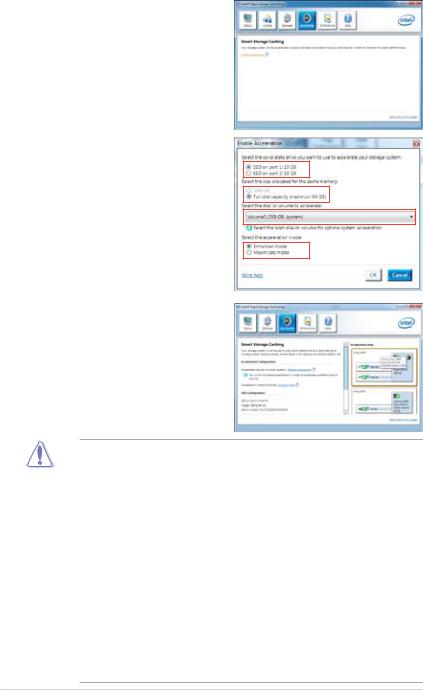
1.Click Accelerate to launch Smart Response Technology settings.
2.a. Select the SSD you want to use to accelerate your storage system.
b. Select the size allocated for SSD caching.
c.Select which HDD for caching.
d.Enhanced mode:WRITE THROUGH, write to SSD and HDD at the same time.
Maximized mode:WRITE BACK, write to SSD and write back to HDD in a later time.
3.Select Disable Acceleration to disable this function and select Change Mode to switch acceleration mode to Enhanced/ Maximus.
•Only Intel® internal SATA ports (gray and blue) support Intel® Smart
Response Technology.
•You need at least one SSD (>18.6GB) and one HDD as a set to enable Intel® Smart Response Technology. A single SSD can only be assigned to one HDD for caching.
•The maximum caching size on the SSD is 64GB. If the SSD exceeds 64GB, storage capacity left out of caching can still be identified by the system for normal storage.
•Be sure to disable the acceleration function of Intel® Smart Response Technology under OS when applying the actions below:
–Removing or replacing the SSD
–Updating IRST 10.5 driver
–Updating BIOS
•If you want to restore the OS, go to BIOS Option ROM utility and select Acceleration Options to disable Intel® Smart Response Technology.
•The performance of Intel® Smart Response Technology varies by SSD.
ASUS P8Z68-V LE |
1-7 |
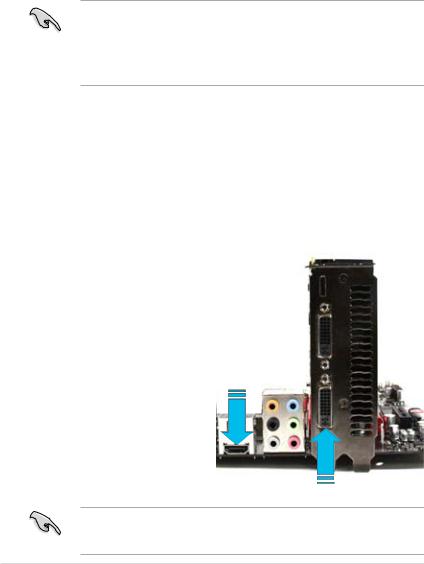
LucidLogix® Virtu™ solution
LucidLogix® Virtu™ is a new generation GPU virtualization software that blurs the line between embedded graphics and discrete GPU for increased graphics performance. Its GPU virtualization dynamically assigns tasks to the best available graphics resources based on power, performance and system load. It allows users to fully utilize the unique capabilities of advanced Sandy Bridge multimedia features alongside the high end 3D rendering performance provided by installed graphics cards. For users with diverse needs, LucidLogix®
Virtu™ GPU virtualization provides great flexibility and efficiency.
•LucidLogix® Virtu™ supports Windows® 7 operating systems.
• Intel® Quick Sync Video feature is supported by Intel® Core™ processor family.
•Supports NVIDIA® GF4xx/ 5xx series & AMD® HD5xxx/ 6xxx series graphic cards.
Hardware installation
To install LucidLogix® Virtu™:
1.Place the support DVD to the optical drive. The Drivers installation tab appears if your computer has enabled the Autorun feature.
2.Click the Drivers tab, then click LucidLogix® Virtu™ software.
3.Follow the onscreen instructions to complete installation.
i-Mode
To use LucidLogix® Virtu™ solution in i-Mode, display must be always connected to Sandy Bridge motherboard video output.
d-Mode (recommended mode)
To use LucidLogix® Virtu™ solution in d-Mode, display must be connected to the discrete GPU installed in the system
i-Mode (output from the Sandy Bridge GPU)
d-Mode (output from the discrete GPU)
Both i-Mode and d-Mode enjoy the performance of Intel® Sandy Bridge built-in media features and discrete card. d-Mode is recommended for enhanced 3D gaming performance.
1-8 |
Chapter 1: Product introduction |

1.4Before you proceed
Take note of the following precautions before you install motherboard components or change any motherboard settings.
• Unplug the power cord from the wall socket before touching any component.
• Before handling components, use a grounded wrist strap or touch a safely grounded object or a metal object, such as the power supply case, to avoid damaging them due to static electricity.
•Hold components by the edges to avoid touching the ICs on them.
•Whenever you uninstall any component, place it on a grounded antistatic pad or in the bag that came with the component.
•Before you install or remove any component, ensure that the ATX power supply is switched off or the power cord is detached from the power supply. Failure to do so may cause severe damage to the motherboard, peripherals, or components.
ASUS P8Z68-V LE |
1-9 |

1.5Motherboard overview
Before you install the motherboard, study the configuration of your chassis to ensure that the motherboard fits into it.
Ensure that you unplug the power cord before installing or removing the motherboard. Failure to do so can cause you physical injury and damage motherboard components.
1.5.1Placement direction
When installing the motherboard, ensure that you place it into the chassis in the correct orientation. The edge with external ports goes to the rear part of the chassis as indicated in the image below.
1.5.2Screw holes
Place six screws into the holes indicated by circles to secure the motherboard to the chassis.
Do not overtighten the screws! Doing so can damage the motherboard.
Place this side |
towards the rear |
of the chassis |
P8Z68-V LE |
|
|
|
|
|
|
|
|
|
|
|
|
|
|
|
|
|
|
|
|
|
|
|
|
|
|
|
|
|
|
|
|
|
|
|
|
|
|
|
|
|
|
|
|
|
|
|
|
|
|
|
|
|
|
|
|
|
|
|
|
|
|
|
|
|
|
|
|
|
|
|
|
|
|
|
|
|
|
|
|
|
|
|
|
|
|
|
|
|
|
|
|
|
|
|
|
|
|
|
|
|
|
|
|
|
|
|
|
|
|
|
|
|
|
|
|
|
|
|
|
|
|
|
|
|
|
|
|
|
|
|
|
|
|
|
|
|
|
|
|
|
|
|
|
|
|
|
|
|
|
|
|
|
|
|
|
|
|
|
|
|
|
|
|
|
|
|
|
|
|
|
|
|
|
|
|
|
|
|
|
|
|
|
|
|
|
|
|
|
|
|
|
|
|
|
|
|
|
|
|
|
|
|
|
|
|
|
|
|
|
|
|
|
|
|
|
|
|
|
|
|
|
|
|
|
|
|
|
|
|
|
|
|
|
|
|
|
|
|
|
|
|
|
|
|
|
|
|
|
|
|
|
|
|
|
|
|
|
|
|
|
|
|
|
|
|
|
|
|
|
|
|
|
|
|
|
|
|
|
|
|
|
|
|
|
|
|
|
|
|
|
|
|
|
|
|
|
|
|
|
|
|
|
|
|
|
|
|
|
|
|
|
|
|
|
|
|
|
|
|
|
|
|
|
|
|
|
|
|
|
|
|
|
|
|
|
|
|
|
|
|
|
|
|
|
|
|
|
|
|
|
|
|
|
|
|
|
|
|
|
|
|
|
|
|
|
|
|
|
|
|
|
|
|
|
|
|
|
|
|
|
|
|
|
|
|
|
|
|
|
|
|
|
|
|
|
|
|
|
|
|
|
|
|
|
|
|
|
|
|
|
|
|
|
|
|
|
|
|
|
|
|
|
|
|
|
|
|
|
|
|
|
|
|
|
|
|
|
|
|
|
|
|
|
|
|
|
|
|
|
|
|
|
|
|
|
|
|
|
|
|
|
|
|
|
|
|
|
|
|
|
|
|
|
|
|
|
|
|
|
|
|
|
|
|
|
|
|
|
|
|
|
|
|
|
|
|
|
|
|
|
|
|
|
|
|
|
|
|
|
|
|
|
|
|
|
|
|
|
|
|
|
|
|
|
|
|
|
|
|
|
|
|
|
|
|
|
|
|
|
|
|
|
|
|
|
|
|
|
|
|
|
|
|
|
|
|
|
|
|
|
|
|
|
|
|
|
|
|
|
|
|
|
|
|
|
|
|
|
|
|
|
|
|
|
|
|
|
|
|
|
|
|
|
|
|
|
|
|
|
|
|
|
|
|
|
|
|
|
|
|
|
|
|
|
|
|
|
|
|
|
|
|
|
|
|
|
|
|
|
|
|
|
|
|
|
|
|
|
|
|
|
|
|
|
|
|
|
|
|
|
|
|
|
|
|
|
|
|
|
|
|
|
|
|
|
|
|
|
|
|
|
|
|
|
|
|
|
|
|
|
|
|
|
|
|
|
|
|
|
|
|
|
|
|
|
|
|
|
|
|
|
|
|
|
|
|
|
|
|
|
|
|
|
|
|
|
|
|
|
|
|
|
|
|
|
|
|
|
|
|
|
|
|
|
|
|
|
|
|
|
|
|
|
|
|
|
|
|
|
|
|
|
|
|
|
|
|
|
|
|
|
|
|
|
|
|
|
|
|
|
|
|
|
|
|
|
|
|
|
|
|
1-10 |
|
|
|
|
|
|
|
|
|
|
|
|
|
|
|
|
|
|
|
Chapter 1: Product introduction |
|||||||||||||
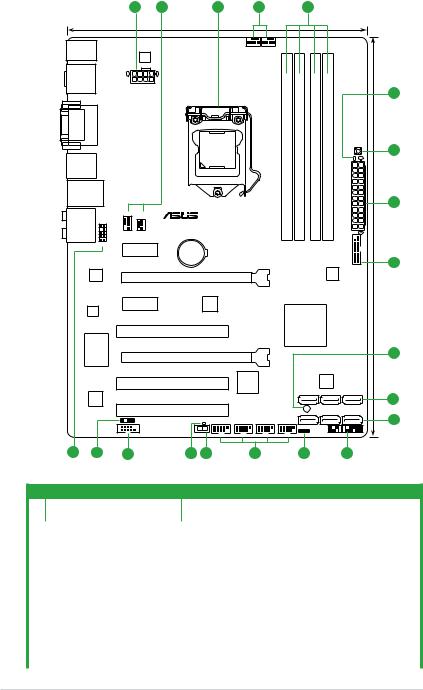
1.5.3Motherboard layout
|
|
1 |
2 |
|
|
3 |
|
2 |
|
4 |
|
|
|
|
|
|
|
|
|
22.9cm(9.0in) |
|
|
|
|
|
|
|
|
|
|
|
|
|
|
|
|
|
CHA_FAN2 |
|
|
|
|
|
|
|
|
|
KB_USB3_34 |
|
|
|
|
|
|
CPU_FAN |
|
|
|
|
|
|
|
|
|
|
EPU |
|
|
|
|
|
|
|
|
|
|
|
|
|
SPDIF_O2 |
|
|
|
|
|
|
|
|
|
|
|
|
|
|
|
HDMI |
|
EATX12V |
|
|
|
|
|
|
|
|
|
|
|
|
|
|
|
|
|
|
|
|
|
|
|
|
|
|
|
5 |
|
|
|
|
|
|
|
|
|
|
|
|
|
|
|
|
|
DVI VGA |
|
|
|
|
LGA1155 |
|
|
|
(64bit,240-pin module) |
(64bit,240-pin module) |
(64bit,240-pin module) |
(64bit,240-pin module) |
|
MemOK! |
6 |
|
|
|
|
|
|
|
|
|
A1 |
A2 |
B1 |
B2 |
DRAM_LED |
|
|
USB3_12 |
|
|
|
|
|
|
|
|
|
|
|||||
|
|
|
|
|
|
|
|
|
DIMM |
DIMM |
DIMM |
DIMM |
|
|
|
LAN1_USB12 |
|
|
|
|
|
|
|
DDR3 |
DDR3 |
DDR3 |
DDR3 |
|
|
|
|
AUDIO |
P8Z68-V LE |
|
|
|
|
|
|
|
|
EATXPWR |
1 |
||||
|
|
CHA_FAN1 PWR_FAN |
|
|
|
|
|
|
|
|
|
|
|
|
30.5cm(12.0in) |
|
AAFP |
|
CMOS Power |
|
|
|
|
|
|
USB3_34 |
|||||
|
|
PCIEX1_1 |
|
Lithium Cell |
|
|
|
|
|
|
|
|
|
|
|
|
|
|
|
|
|
|
|
|
|
|
|
ASM |
|
7 |
|
|
ASM |
|
|
|
|
|
|
|
|
|
|
|
|
||
|
1042 |
|
|
PCIEX16_1 |
|
|
|
|
|
|
|
1042 |
|
|
|
|
|
|
|
|
|
|
|
|
|
|
|
|
|
||
|
|
PCIEX1_2 |
|
|
TPU |
|
|
|
|
|
|
|
|
|
|
|
RTL |
|
|
|
|
|
|
|
|
|
|
|
|
|
|
|
8111E |
|
|
|
|
|
|
|
|
|
|
|
|
|
|
|
|
|
|
|
|
|
|
|
|
Intel® |
|
|
|
|
|
|
|
|
|
PCI1 |
|
|
|
|
|
Z68 |
|
|
|
|
|
|
Super |
|
|
|
|
|
|
|
|
|
|
|
|
|
8 |
|
I/O |
|
|
PCIEX16_2 |
|
|
|
|
|
|
|
|
|
|
|
|
|
|
|
|
|
|
|
|
|
|
|
|
|
||
|
|
|
|
PCI2 |
|
|
ASM |
|
|
|
|
64Mb |
|
|
|
|
|
|
|
|
|
1083 |
|
|
|
|
BIOS |
|
|
|
|
|
|
|
|
|
|
|
|
|
|
|
|
|
|
|
|
|
|
|
|
|
|
|
|
|
|
SATA3G_2 |
SATA3G_3 |
SATA3G_4 |
9 |
||
|
ALC |
|
|
|
|
|
|
|
|
|
|
|
|
|
|
|
892 |
|
|
|
|
|
|
|
|
|
|
|
|
|
|
|
|
|
|
PCI3 |
|
|
|
|
SB_PWR |
|
SATA6G_2 |
SATA6G_1 |
|
||
|
|
|
|
|
|
|
|
|
|
10 |
|||||
|
|
SPDIF_OUT |
ELED730 |
|
|
|
SATA3G_1 |
|
|
|
|
||||
|
|
COM1 |
|
|
|
|
|
|
|
CLRTC |
|
|
|
|
|
|
|
|
|
|
|
|
|
|
|
PANEL |
|
|
|
||
|
|
|
|
|
TPU |
USB1112 |
USB910 |
USB78 |
USB56 |
|
|
|
|
||
|
|
|
|
|
|
|
|
|
|
|
|||||
18 |
17 |
16 |
|
15 |
14 |
|
13 |
|
12 |
|
|
|
11 |
|
|
1.5.4Layout contents
Connectors/Jumpers/Slots/LED
1.ATX power connectors
(24-pin EATXPWR, 8-pin EATX12V)
Page |
Connectors/Jumpers/Slots/LED |
Page |
|
1-33 |
10 |
Intel® Z68 Serial ATA 6.0 Gb/s connectors (7-pin |
1-31 |
|
|
SATA6G_1/2 [gray]) |
|
|
|
CPU, Chassis and power fan connectors |
|
|
|
|
|
2. |
(4-pin CPU_FAN, 4-pin CHA_FAN1/2, |
1-32 |
11. |
System panel connector (20-8 pin PANEL) |
1-34 |
|
|
|
|
3-pin PWR_FAN) |
|
|
|
|
|
|
3. |
Intel® CPU socket |
1-12 |
12 |
Clear RTC RAM (3-pin CLRTC) |
1-26 |
|
|
4. |
DDR3 DIMM sockets |
1-17 |
. |
USB connectors (10-1 pin USB5~12) |
1-31 |
|
13. |
|
||||||
|
5. |
DRAM LED |
1-37 |
14 |
TPU switch |
1-36 |
|
|
6. |
MemOK! switch |
1-35 |
15. |
TPU LED (ELED 730) |
1-37 |
|
|
7. |
USB 3.0 connector (20-1 pin USB3_34) |
1-32 |
16. |
Serial port connectors (10-1 pin COM1) |
1-29 |
|
|
8. |
Onboard LED (SB_PWR) |
1-36 |
17. |
Digital audio connector (4-1 pin SPDIF_OUT) |
1-30 |
|
9. |
Intel® Z68 Serial ATA 3.0 Gb/s connectors |
1-30 |
18. |
Front panel audio connector (10-1 pin AAFP) |
1-29 |
|
|
|
|
(7-pin SATA3G_1–4 [blue]) |
|
|
|
|
|
ASUS P8Z68-V LE |
1-11 |
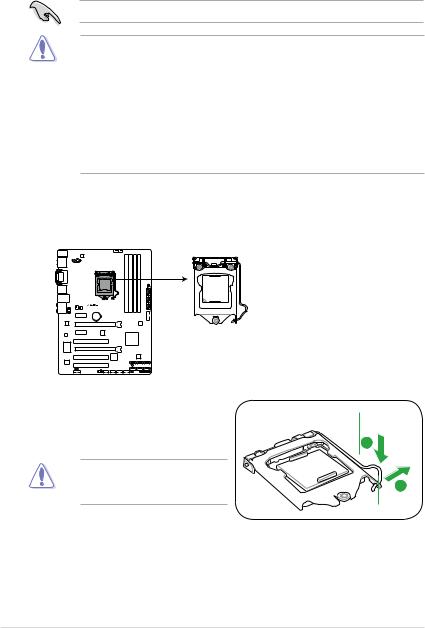
1.6Central Processing Unit (CPU)
The motherboard comes with a surface mount LGA1155 socket designed for the Intel® 2nd Generation Core™ i7 / Core™ i5 / Core™ i3 processors.
Unplug all power cables before installing the CPU.
• Upon purchase of the motherboard, ensure that the PnP cap is on the socket and the socket contacts are not bent. Contact your retailer immediately if the PnP cap is missing, or if you see any damage to the PnP cap/socket contacts/motherboard components. ASUS will shoulder the cost of repair only if the damage is shipment/transit-related.
•Keep the cap after installing the motherboard. ASUS will process Return Merchandise
Authorization (RMA) requests only if the motherboard comes with the cap on the
LGA1155 socket.
•The product warranty does not cover damage to the socket contacts resulting from incorrect CPU installation/removal, or misplacement/loss/incorrect removal of the PnP cap.
1.6.1Installing the CPU
To install a CPU:
1.Locate the CPU socket on the motherboard.
P8Z68-V LE
P8Z68-V LE CPU socket LGA1155
2.Press the load lever with your thumb (A),
and then move it to the right (B) until it is released from the retention tab.
To prevent damage to the socket pins, do not remove the PnP cap unless you are installing a CPU.
Load lever
B

 Retention tab
Retention tab
1-12 |
Chapter 1: Product introduction |
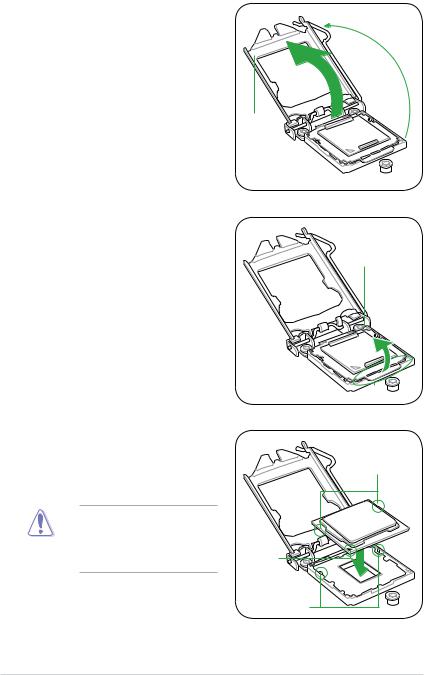
3.Lift the load lever in the direction of the arrow until the load plate is completely lifted.
4.Remove the PnP cap from the CPU socket by lifting the tab only.
5.Position the CPU over the socket, ensuring that the gold triangle is on the bottom left corner of the socket, and then fit the socket alignment keys into the CPU notches.
PnP cap
CPU notches
The CPU fits in only one correct orientation. DO NOT force the CPU into the socket to prevent bending the connectors on the socket and damaging the CPU!
Gold |
triangle |
mark |
Alignment keys |
ASUS P8Z68-V LE |
1-13 |
